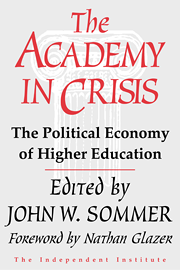Lawmakers in Washington have missed a strategic opportunity this year to fundamentally re-engineer the largest federal student loan program. Congress has taken it as an article of faith that the Federal Family Education Loan Program (FFEL), the Johnson-era plan that guarantees student loans by private lenders, requires merely trimming some of the more obvious fat around its edges. Unfortunately, after a 30-year feast on pork-filled federal subsidies, the bloated FFEL program now requires major liposuction.
Although the Republican-controlled Congress seems to have successfully halted the Clinton Administration’s plan to make the U. S. Department of Education the monopoly source of student loans via the Federal Direct Student Loan Program (FDSL), it has failed to recognize that the traditional FFEL program is beset with major design flaws. Like many social welfare programs of the 1960s, the FFEL has evolved into a complex system of costly subsidies and cumbersome procedures, driven by pressure group dynamics and acting against the long-run interests of taxpayers, colleges, and the student-consumers it was intended to benefit.
An outgrowth of the Higher Education Act of 1965, the FFEL program has become the primary source of financial aid for students attending both traditional universities and career-oriented colleges and trade schools. Since its inception, the FFEL program has subsidized the origination of 74 million student loans by private banks and other lenders, with total volume exceeding $180 billion. In fiscal year 1994, more than six million loans totaling nearly $22 billion were disbursed.
The FFEL program design is supposed to be simple. College students apply for loans through their financial aid office. The amount of loan subsidy depends on the student’s personal and family income. Private banks and other financial institutions provide the loan capital, which is guaranteed against default, death, or permanent disability by various guarantee agencies. The federal government provides reinsurance funds to the direct guarantors. A combination of subsidies is designed to encourage lenders and guarantors to participate in the program, from paying a student’s interest while the student is in school to providing guarantors with reinsurance funds and administrative cost allowances. Over the years, these subsidies have created a giant student loan bureaucracy.
In addition to the several thousand participating lenders, more than 40 state and non-profit guarantee agencies, not to mention countless secondary market loan holders, servicers, collection agencies, eligible institutions of higher education, consultants, law firms, and other hangers-on are tied to this federally-sponsored bureaucracy. While lenders furnish the up-front loan capital, the FFEL’s structure of fees and subsidies takes a top-down bureaucratic process-oriented approach that has led to complexity and inefficiency, if not downright absurdity in some respects. If the FFEL program is to be successfully re-engineered for the 21st century, it must become more fully privatized, both in order to achieve more efficiencies and to replace legislatively fixed subsidies with market-driven prices for services.
The first step in privatization can be addressed easily and quickly. Congress should enact a proposal by Senator Paul Simon (D-IL) to privatize loan guarantor services such as payment of default claims and collection of defaulted loans. Lawmakers who have supported retention of the FFEL program because it relies on private-sector sources of loan capital—to be philosophically consistent—should withdraw support for the essentially non-private system of guarantor services, a system which has inappropriately benefited from a major legislative mistake in the mid-1970s, when Congress enacted a sweeping package of lavish subisidies to incentivize states to form or authorize their own guarantee agencies.
The current system of paying high fixed subsidies to state guarantee agencies and some putatively non-profit guarantors flies in the face of what we know about free market processes. Senator Simon has correctly described the pork barrel nature of guarantor subsidies when he recently observed: “The original idea was that these agencies would take on some risk. But risk-sharing was later abandoned while the guarantee agency structure remained.”
From a taxpayer viewpoint, the present system ought to trigger outrage. Never have any of the guarantee agency subsidy costs been related to any real market-driven pricing structure for the same services. Literally billions of dollars have been spent in funding agency reserves, paying up-front administrative cost allowances, and covering the agencies’ costs of collecting on defaulted student loans on top of paying for the defaults in the first place. The General Accounting Office has been particularly critical of paying guarantors extra money to collect on defaulted loans, arguing that guarantors “have more financial incentive to expend resources collecting defaulted loans than working with borrowers to prevent defaults.”
It gets worse. Many guarantee agencies have entered the business of servicing FFEL loans for banks. Then, when a loan goes into default, the guarantor pays off the bank’s insurance claim and begins collection on the loan, meanwhile passing Go and collecting the double federal subsidy. The GAO and USDE’s Inspector General view this practice as a serious conflict of interest since the guarantors, who are required by USDE regulations to verify that proper servicing was done in order to qualify the loan for the default guarantee, wind up policing their own servicing practices. The fox guards the henhouse, and gets paid for doing so!
Another example of this Kafkaesque system makes one want to cry. A couple of years ago USDE auditors uncovered a massive computer system foulup in the California Student Aid Commission’s guarantor operations. Among other things, the California agency’s computer was failing to send the required pre-claims assistance notices to colleges. These notices are requests for help in preventing a possible loan default by a student borrower whose loan has become delinquent. Often, the college the student attended will have an updated address through its alumni records that can assist the guarantor in locating a missing borrower and negotiating a repayment plan to avoid default. The California computer snafu meant that colleges were completely unaware that a loan was about to go into default and powerless to do anything to help. Yet, under the complex FFEL rules, the innocent colleges had to pay the price of having these defaults count against their so-called cohort rate, which meant that some colleges in California have stood the risk of losing eligibility to participate in the FFEL program, suffering for the sins of the guarantee agency.
Privatizing guarantor services could be accomplished quickly and easily, with no disruption to the FFEL delivery system. Under the Simon proposal, the current agreements between the Department of Education and guarantee agencies would be terminated and replaced by competitive contracts. Selection of a half-dozen qualified guarantors through a competitive bidding process would ensure internal competition among the firms selected to keep costs down and services up.
This model for federal procurement has been proven effective by numerous agencies, including the USDE, in contracting out loan collection services. Existing loan portfolios could be reassigned to the private contract guarantors using the Secretary of Education’s existing FFEL program authority. Some $1.6 billion in outstanding guarantee agency reserve funds would be recaptured by September 1997 under the Simon proposal and scored as budget savings.
Republicans should not be dissuaded by partisanship in looking seriously at the Simon proposal, nor should they link this particular initiative with the fact that Senator Simon has been a vocal proponent of the Administration’s FDSL program. Simon has always had a maverick streak in him, and his opposition to the guarantee agency boondoggle stems from his more fundamental disdain for unnecessary middlemen in the student loan delivery system.
Other opportunities for privatization can be explored as well. For example, there is no reason on earth why the federal government should be involved in processing claims for student loans canceled due to death or permanent disability. Private insurance coverage for such contingencies could be purchased through a user fee charged at the time of loan origination. Such fees are bound to be inexpensive, given the healthy actuarial statistics on typical student loan borrowers.
Privatization can also lead to simplification of FFEL red tape. For example, as a result of their near-death experience faced with the Clinton Administration’s endorsement of direct lending, major student loan lenders have worked together over the past two years to radically simplify the loan origination process, one of the most frustrating aspects of student loans for students and campus administrators. Ironically, another improvement, a privately-developed electronic loan application form, was rejected by the USDE on technical legal grounds, even though it would have simplified and technologically modernized the loan process.
Privatizing database support for the massive FFEL program is already underway. The National Student Loan Data System (NSLDS) which has been activated by USDE in recent years is already paying off in preventing fraud and abuse by halting loan origination to defaulters and other unqualified would-be borrowers. In the near future, the NSLDS will link up student information for both the FFEL and Pell Grant programs, thus solving a major headache for many college aid administrators of integrating application processing and delivery to students of these two multi-billion-dollar federal programs.
The NSLDS is achieving these successes through competitive private sector contracts, not by building a bigger cadre of permanent bureaucrats. Congress could assist this process by restructuring the way the FFEL and Pell Grant programs are authorized under the Higher Education Act, so as to treat these major student loan and grant programs as twin parts of a system of student aid, instead of as separate federal programs in separate legislatively compartmentalized boxes.
Finally, the Federal Perkins Loan Program, a campus-based revolving fund loan program that dates back to the National Defense Student Loans of 1958, needs to be phased out and privatized. There is no good rationale for adding new federal capital to the multi-billion-dollar Perkins Loan funds on participating college campuses. Such funds are narrowly targeted and unnecessary given the broad availability of FFEL funds. Earlier this year, the House Appropriations Committee estimated that $1.1 billion would be saved over the next seven years by eliminating Perkins Loan federal capital contributions.
At the same time, the corpus of Perkins Loan revolving funds in repayment to colleges and universities should be permanently deeded over to those campuses and detailed regulations eliminated. By thus privatizing the outstanding Perkins loan capital in one stroke, Congress would invest colleges with the positive stewardship qualities of owners, rather than the grudging obedience to regulatory dictates of serfs. The privatization of Perkins Loans would resemble, in many respects, successful efforts to transfer ownership of public housing to residents.
There is much unfinished business in reshaping the student loan program to better satisfy taxpayers, students, and colleges. The recent debate over direct federally-financed student loans versus subsidized privately-financed loans has been vigorous and healthy in causing official Washington to face the question posed by Rep. John Boehner (R-OH): “Is turning the Department of Education into one of the nation’s largest lenders part of a sensible strategy to transform government?” But now that the debate appears to be ending and the traditional FFEL program appears to have won a political victory, Congress would do well to look to additional opportunities for privatization of student loans as part of its 1996 legislative agenda.








